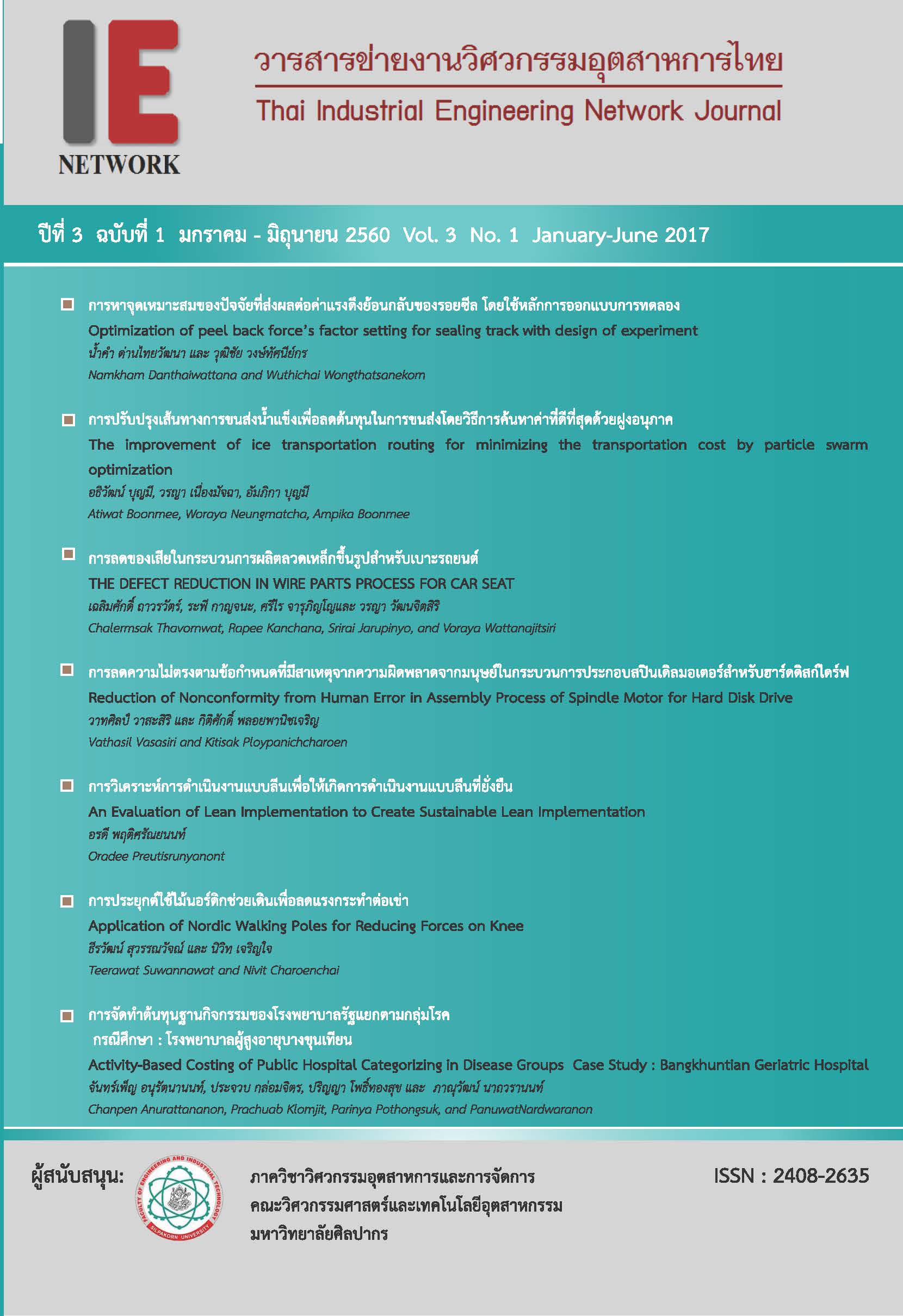The Influence of Surface Modification on Tensile Strength of Single Sisal Fibre
Main Article Content
Abstract
This research aims to study the influence of surface modification on tensile strength of single sisal fibre. It is to compare between 2 groups of fibres: one with surface modification and one without. The fibres were immersed in 1 M concentration of NaOH solution at 60oC by ultrasonic process for 30, 60, and 90 min respectively. The tensile strength of single sisal fibre was conducted by fibre testing Instrument according to ASTM D2256-02 Standard. From experimental results, it is found that the treated fibre had cleaner surface than the untreated fibre. Compared to the untreated fibre treated fibre also had higher tensile strength and percent elongation. However, the tensile strength would be decreased if the fibres were immersed longer in the solution.
Article Details
บทความ ข้อมูล เนื้อหา รูปภาพ ฯลฯ ที่ได้รับการตีพิมพ์ในวารสารฯ ถือเป็นลิขสิทธิ์ของวารสารฯ หากบุคคลหรือหน่วยงานใดต้องการนำทั้งหมดหรือส่วนหนึ่งส่วนใดไปเผยแพร่ต่อหรือเพื่อกระทำการใดๆ จะได้รับอนุญาต แต่ห้ามนำไปใช้เพื่่อประโยชน์ทางธุรกิจ และห้ามดัดแปลง
References
[2] H. M. Mustafa and D. Benjamin, Unsaturated Polyester Resin Reinforced With Chemically Modified Natural Fibre, IOSR Journal of Polymer and Textile Engineering (IOSR-JPTE) 1, 31-38 (2014).
[3] R. Malkapuram, V. Kumar and S.N. Yuvraj, Recent Development in Natural Fibre Reinforced Polypropylene Composites, Journal of Reinforced Plastics and Composites 28, 1169-1189 (2008).
[4] P. Wambua, J. Ivens and I.Verpoest, Natural Fibres: Can They Replace Glass in Fibre Reinforced Plastics, Composites Science and Technology 63, 1259-1264 (2003).
[5] L. Yan, W. M. Yiu, and Y. Lin, Sisal fibre and its composites: a review of recent developments, Composites Science and Technology 60, 2037-2055 (2000).
[6] M. J. John and R. D. Anandjiwala, Recent developments in chemical modification and characterization of natural fiber-reinforced composites, Polym. Compos. 29, 187–207 (2008).
[7] A. M. Mohd Edeerozey, H. Md. Akil, A. B. Azhar and M. I. Zainal Ariffin, Chemical modification of kenaf fibres, Mater. Lett. 61, 2023–2025 (2007).
[8] มานพ พิพัฒหัตถกุล, ประยูร สุรินทร์ และ เจษฎา วงษ์อ่อน, การดัดแปลงพื้นผิวของเส้นใยป่านศรนารายณ์เสริมแรงในพอลิเมอร์คอมโพสิท: ทบทวนวรรณกรรม, วารสารวิชาการปทุมวัน ปีที่ 5 ฉบับที่ 14 กันยายน – ธันวาคม 2558
[9] C. Navin and S.A.R. Hashmi, Mechanical properties of sisal fibre at elevated temperatures, Journal of Materials Science 28, 6724-6728 (1993).
[10] C. Donghwan Cho, Y. B. Sung and T. Drzal, Cellulose-Based Natural Fiber Topography and the Interfacial Shear Strength of Henequen/Unsaturated Polyester Composites: Influence of Water and Alkali Treatments, Composite Interfaces 16, 769–779 (2009).
[11] K. A. Mohd, G. Sapana, P. Prabha, M. Deepti, M. Manish and D. Savita, Characterisation Studies and Impact of Chemical Treatment on Mechanical Properties of Sisal Fiber, Composite Interfaces 18, 527–541 (2011).
[12] M. M. Kabir, H. Wang, K. T. Lau, F. Cardona, Chemical treatments on plant-based natural fibre reinforced polymer composites: An overview, Composites: Part B 43, 2883-2892 (2012).
[13] S. Fakirov, D. Bhattacharyya, Handbook of Engineering biopolymers: Homopolymers, Blends and Composites, Munich Hanser Publishers, 2007.
[14] K. S. Suslick, L. A. Crum, Sonochemistry and Sonoluminescence, in Handbook of Acoustics, M. J. Crocker (Eds.), Wiley-Interscience: New York, 243-253 (1998).

